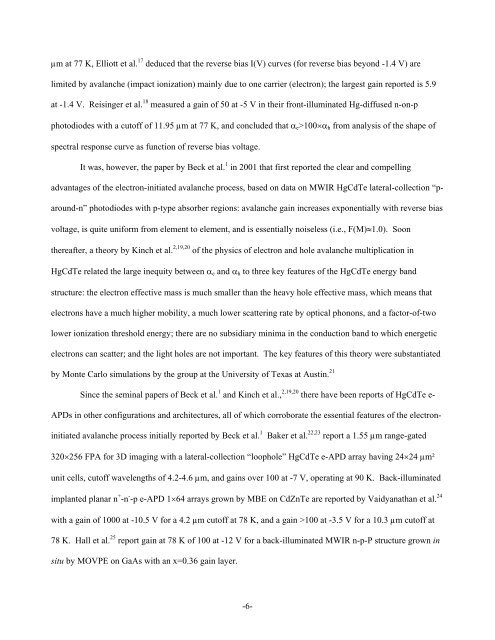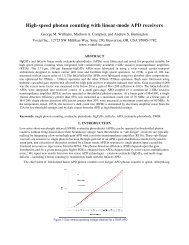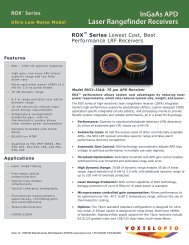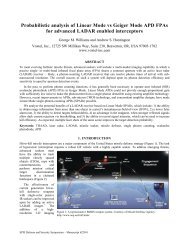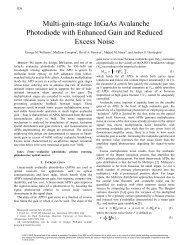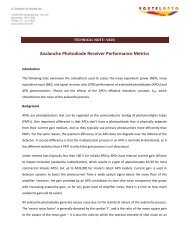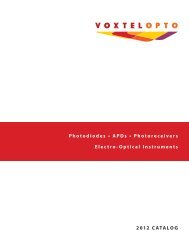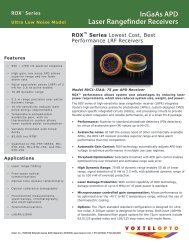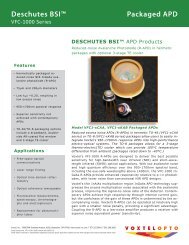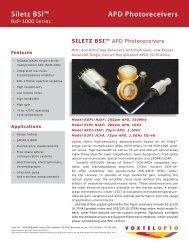Characterization of HgCdTe MWIR Back-Illuminated II-VI-07 ... - Voxtel
Characterization of HgCdTe MWIR Back-Illuminated II-VI-07 ... - Voxtel
Characterization of HgCdTe MWIR Back-Illuminated II-VI-07 ... - Voxtel
- No tags were found...
Create successful ePaper yourself
Turn your PDF publications into a flip-book with our unique Google optimized e-Paper software.
µm at 77 K, Elliott et al. 17 deduced that the reverse bias I(V) curves (for reverse bias beyond -1.4 V) are<br />
limited by avalanche (impact ionization) mainly due to one carrier (electron); the largest gain reported is 5.9<br />
at -1.4 V. Reisinger et al. 18 measured a gain <strong>of</strong> 50 at -5 V in their front-illuminated Hg-diffused n-on-p<br />
photodiodes with a cut<strong>of</strong>f <strong>of</strong> 11.95 µm at 77 K, and concluded that α e >100×α h from analysis <strong>of</strong> the shape <strong>of</strong><br />
spectral response curve as function <strong>of</strong> reverse bias voltage.<br />
It was, however, the paper by Beck et al. 1 in 2001 that first reported the clear and compelling<br />
advantages <strong>of</strong> the electron-initiated avalanche process, based on data on <strong>MWIR</strong> <strong>HgCdTe</strong> lateral-collection “paround-n”<br />
photodiodes with p-type absorber regions: avalanche gain increases exponentially with reverse bias<br />
voltage, is quite uniform from element to element, and is essentially noiseless (i.e., F(M)≈1.0). Soon<br />
thereafter, a theory by Kinch et al. 2,19,20 <strong>of</strong> the physics <strong>of</strong> electron and hole avalanche multiplication in<br />
<strong>HgCdTe</strong> related the large inequity between α e and α h to three key features <strong>of</strong> the <strong>HgCdTe</strong> energy band<br />
structure: the electron effective mass is much smaller than the heavy hole effective mass, which means that<br />
electrons have a much higher mobility, a much lower scattering rate by optical phonons, and a factor-<strong>of</strong>-two<br />
lower ionization threshold energy; there are no subsidiary minima in the conduction band to which energetic<br />
electrons can scatter; and the light holes are not important. The key features <strong>of</strong> this theory were substantiated<br />
by Monte Carlo simulations by the group at the University <strong>of</strong> Texas at Austin. 21<br />
Since the seminal papers <strong>of</strong> Beck et al. 1 and Kinch et al., 2,19,20 there have been reports <strong>of</strong> <strong>HgCdTe</strong> e-<br />
APDs in other configurations and architectures, all <strong>of</strong> which corroborate the essential features <strong>of</strong> the electroninitiated<br />
avalanche process initially reported by Beck et al. 1<br />
Baker et al. 22,23 report a 1.55 µm range-gated<br />
320×256 FPA for 3D imaging with a lateral-collection “loophole” <strong>HgCdTe</strong> e-APD array having 24×24 µm²<br />
unit cells, cut<strong>of</strong>f wavelengths <strong>of</strong> 4.2-4.6 µm, and gains over 100 at -7 V, operating at 90 K. <strong>Back</strong>-illuminated<br />
implanted planar n + -n - -p e-APD 1×64 arrays grown by MBE on CdZnTe are reported by Vaidyanathan et al. 24<br />
with a gain <strong>of</strong> 1000 at -10.5 V for a 4.2 µm cut<strong>of</strong>f at 78 K, and a gain >100 at -3.5 V for a 10.3 µm cut<strong>of</strong>f at<br />
78 K. Hall et al. 25 report gain at 78 K <strong>of</strong> 100 at -12 V for a back-illuminated <strong>MWIR</strong> n-p-P structure grown in<br />
situ by MOVPE on GaAs with an x=0.36 gain layer.<br />
-6-


